Emerging into Denver International airport's Great Hall from the train from the city, one sees a terminal bursting at its seams.
Security queues take up most of the space, called the "fishbowl" by airport officials, with the corridors around them narrow and crowded with travellers trying to figure out where to go. Accessing the ticket counters on the level can be a bit like a salmon swimming upstream, moving against the flow of passengers making their way to security.
Welcome to Denver airport circa 2018, when record numbers of travellers pass through the quarter-century old facility nearly weekly.
"Tomorrow the airport will set a record for passengers – we've been setting records almost every Friday," says Stu Williams, senior vice-president of special projects at Denver airport, on a recent tour of the work underway to improve the Great Hall.
Denver handled 61.4 million passengers in 2017, surpassing New York John F Kennedy to become the fifth busiest airport in the USA, and it is on track to hit another record this year with 64 to 65 million passengers forecast.
All of those travellers will pass through a facility designed for roughly 50 million passengers annually that has remained largely unchanged since it opened in 1995. In addition, the majority of that traffic was forecast to connect, where, in reality, the majority was travelling to and from Denver itself.

Denver airport's Great Hall before and after the post-9/11 security changes
Denver airport
"On any busy summer day or during ski season, and you can see that both level six and level five are full of passengers and its difficult to move around," said Scott Kirby, president of the airport's largest carrier, United Airlines, at a meeting on Great Hall improvements in July 2017.
Denver has kicked off a $3.5 billion programme to catch up with current demand and prepare for a future of far more than 50 million passengers. That includes a more intuitive and passenger-friendly terminal, more gates and other airfield improvements that should be ready by the early 2020s.
INTUITIVE GROWTH
Denver airport's iconic Jeppesen terminal roofline is instantly recognisable. The roof's white peaks mimic the nearby Rocky Mountains but hide the daily crowds inside.
"Right now the [terminal] building – the roof is magnificent – but inside, because of many factors, security has taken over much of the space," says Ignacio Castejon, chief executive of Great Hall Partners, the company led by Spanish infrastructure operator Ferrovial hired to redevelop the terminal.
The up to $770 million Great Hall project aims to increase capacity while bringing some order to the chaos, creating an "intuitive" flow, as Williams puts it, to the congestion created by the additional security measures implemented after 11 September 2001.
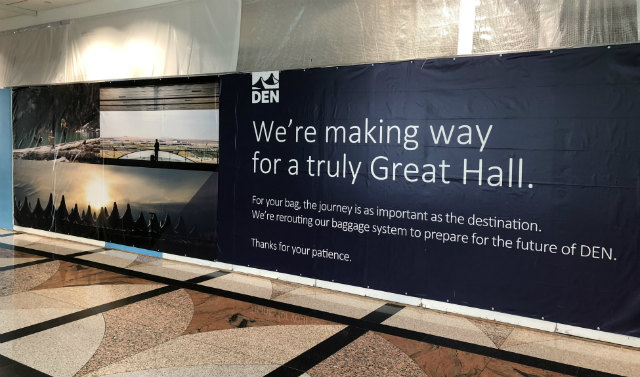
Edward Russell
Ticket counters will be reconfigured into pods. This will increase the number of counter and kiosk positions by up to 44%, while reducing their physical footprint by about a third, the airport's plans show.
The security checkpoints that mar the Great Hall will move upstairs to the ticketing level, and relocate to the northeast and northwest sides of the terminal from the centre. Departing passengers will flow north from either ticket counters or the train from the city to those new checkpoints, and then down to a new post-security plaza in the northern two-thirds of the hall, and on down to the concourse train for a ride to their gate.

Great Hall post-renovations layout
Denver airport
The work is not without controversy. Airlines balked at the price tag and timeline when the project was approved by the Denver City Council in August 2017.
"It is an exciting time for the airlines serving Denver," nine airlines serving the airport, including the three largest Frontier Airlines, Southwest Airlines and United, wrote to airport chief executive Kim Day that month. "We support [Denver]'s project to build new gates… The proposed Great Hall project, on the other hand, restricts the airport's ability to support airline growth."
The decision to add concessions in the new post-security Great Hall plaza was a poor decision by the airport, they said, noting that passengers prefer to dwell and shop near their departure gates that are a train ride away from the space.
BALANCING ACT
Denver aims to walk a fine line with the Great Hall project, balancing airlines' needs for additional space to grow with improving passenger flow and adding desired amenities. The airport is already acknowledged as one of the better large airports in the USA, landing fifth in JD Power's 2017 North American airport satisfaction survey just ahead of Charlotte and just behind Phoenix, but it could do better.
"Denver does do a great job," says Michael Taylor, travel practice lead at JD Power. "The thing they probably need to work on the most is food and beverage, and retail."
The Great Hall project, while first about increasing capacity and improving passenger flow and safety in the terminal, aims to address just that – retail concessions and food – in the new post-security plaza.
"This project prepares Denver International airport well for our future, while raising the bar as we look at our industry peers," said Day in August 2017.
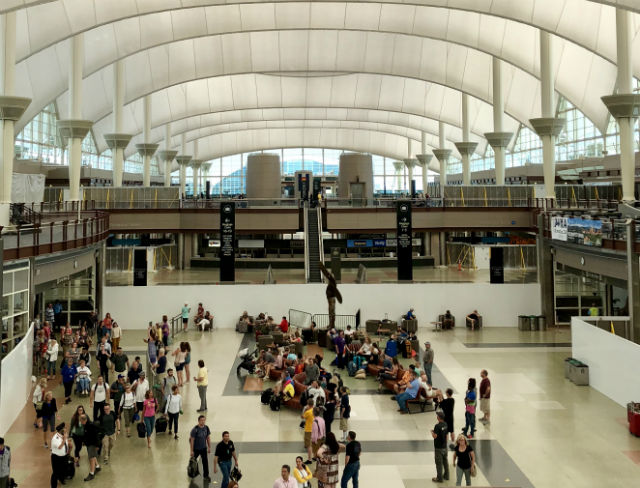
Construction in the Great Hall began in July
Edward Russell
GATES, GATES, GATES
Airlines are growing and want more space. Denver airport has responded with plans to add 39 gates to its three concourses – 12 on A, 11 on B and 16 on C – by telescoping them to the east and west.
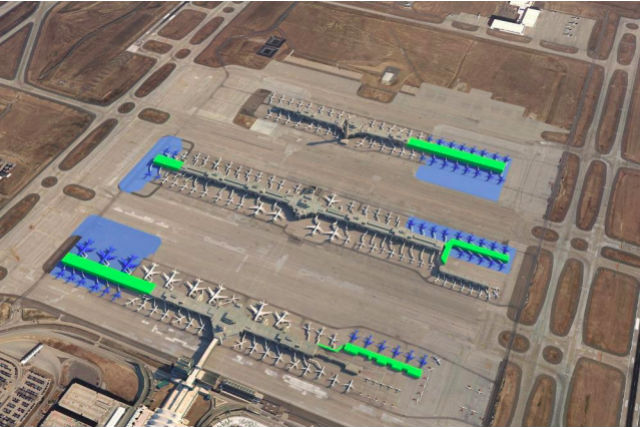
The concourse extensions at Denver airport
Denver airport
"We knew we were out of gates," Mark Adams, senior director of development, tells FlightGlobal on the capital plans that began coming together three years ago. "There was enough pressure to build it all now… [and] by the time we open, every gate is going to be leased."
United, the airport's largest carrier, has said it will use all 11 gates planned for concourse B, with Kirby saying in 2017 that the airline plans to grow passenger numbers by about 50% in the coming years.
"We’re excited to begin the airport’s expansion programme," the Chicago-based carrier tells FlightGlobal. "We’re proud of the growth and success United shares with the city of Denver."
United grew flights at Denver by 8.1% year on year in the first half of 2018, and plans to grow them by another 11.7% in the second half, FlightGlobal schedules data shows. Its capacity at the airport is scheduled to increase 9.6% year on year in 2018.
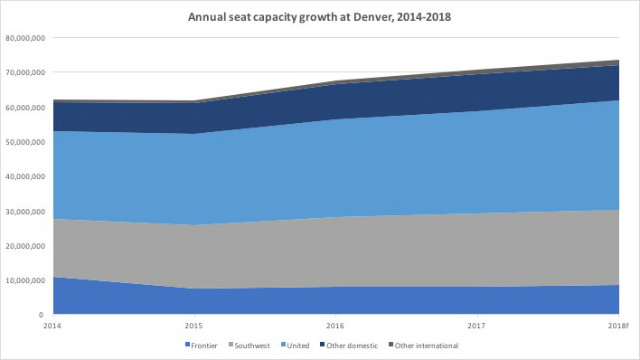
FlightGlobal schedules
Which airlines will use the additional gates in A and C has yet to be determined, with Southwest and Frontier – the airport's second and third largest carriers, respectively – mum on their plans for the additional space.
Frontier is scheduled to increase flights 6.5% and Southwest 0.8% at Denver this year, schedules show.
In the meantime, United will use a nine-gate temporary extension of concourse A during construction on B, says Adams. The works require demolishing a 12-gate regional finger on the east end of B and rebuilding it for mainline aircraft.
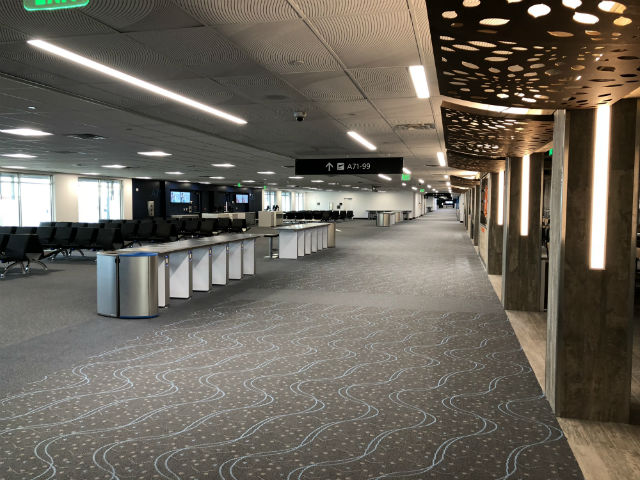
Temporary concourse A gates at Denver airport
Edward Russell
The concourse extensions also include new hold rooms, where passengers wait for flights, for both the new gates and those added in recent years to allow for the physical expansion to be built.
"They've got the right priorities in mind," says JD Power's Taylor on the capital works at Denver. "I'm very optimistic that they're going to create a nice experience."
Source: Cirium Dashboard






















